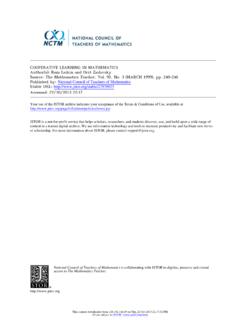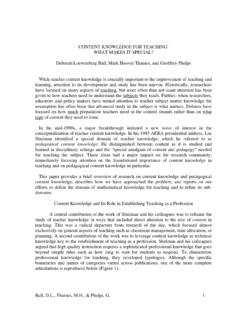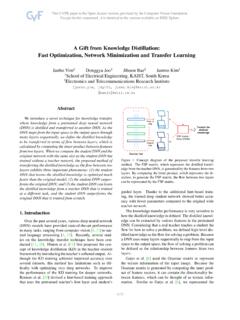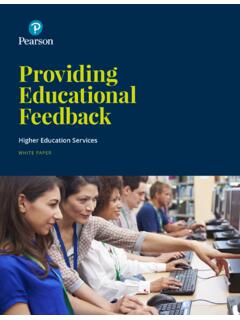Transcription of What Is Technological Pedagogical Content Knowledge?
1 Koehler, M. J., & Mishra, P. (2009). What is Technological Pedagogical Content knowledge ? Contemporary Issues in Technology and Teacher Education, 9(1), 60-70. 60 Editors Note: For the benefit of readers who are unfamiliar with the notion of technology, pedagogy, and Content knowledge (TPACK), we offer the following condensed and updated depiction by Mishra and Koehler (2007), which was presented originally at the annual conference of the Society for Information Technology and Teacher Education in 2007. Judi Harris & Matt Koehler Special Issue Guest Editors What Is Technological Pedagogical Content knowledge ? Matthew J. Koehler and Punya Mishra Michigan State University Abstract This paper describes a framework for teacher knowledge for technology integration called Technological Pedagogical Content knowledge (originally TPCK, now known as TPACK, or technology, pedagogy, and Content knowledge ). This framework builds on Lee Shulman s construct of Pedagogical Content knowledge (PCK) to include technology knowledge .
2 The development of TPACK by teachers is critical to effective teaching with technology. The paper begins with a brief introduction to the complex, ill-structured nature of teaching. The nature of technologies (both analog and digital) is considered, as well as how the inclusion of technology in pedagogy further complicates teaching. The TPACK framework for teacher knowledge is described in detail, as a complex interaction among three bodies of knowledge : Content , pedagogy, and technology. The interaction of these bodies of knowledge , both theoretically and in practice, produces the types of flexible knowledge needed to successfully integrate technology use into teaching. Contemporary Issues in Technology and Teacher Education, 9(1) 61 As educators know, teaching is a complicated practice that requires an interweaving of many kinds of specialized knowledge . In this way, teaching is an example of an ill-structured discipline, requiring teachers to apply complex knowledge structures across different cases and contexts (Mishra, Spiro, & Feltovich, 1996; Spiro & Jehng, 1990).
3 Teachers practice their craft in highly complex, dynamic classroom contexts (Leinhardt & Greeno, 1986) that require them constantly to shift and evolve their understanding. Thus, effective teaching depends on flexible access to rich, well-organized and integrated knowledge from different domains (Glaser, 1984; Putnam & Borko, 2000; Shulman, 1986, 1987), including knowledge of student thinking and learning, knowledge of subject matter, and increasingly, knowledge of technology. The Challenges of Teaching With Technology Teaching with technology is complicated further considering the challenges newer technologies present to teachers. In our work, the word technology applies equally to analog and digital, as well as new and old, technologies. As a matter of practical significance, however, most of the technologies under consideration in current literature are newer and digital and have some inherent properties that make applying them in straightforward ways difficult.
4 Most traditional Pedagogical technologies are characterized by specificity (a pencil is for writing, while a microscope is for viewing small objects); stability (pencils, pendulums, and chalkboards have not changed a great deal over time); and transparency of function (the inner workings of the pencil or the pendulum are simple and directly related to their function) (Simon, 1969). Over time, these technologies achieve a transparency of perception (Bruce & Hogan, 1998); they become commonplace and, in most cases, are not even considered to be technologies. Digital technologies such as computers, handheld devices, and software applications by contrast, are protean (usable in many different ways; Papert, 1980); unstable (rapidly changing); and opaque (the inner workings are hidden from users; Turkle, 1995).On an academic level, it is easy to argue that a pencil and a software simulation are both technologies. The latter, however, is qualitatively different in that its functioning is more opaque to teachers and offers fundamentally less stability than more traditional technologies.
5 By their very nature, newer digital technologies, which are protean, unstable, and opaque, present new challenges to teachers who are struggling to use more technology in their teaching. Also complicating teaching with technology is an understanding that technologies are neither neutral nor unbiased. Rather, particular technologies have their own propensities, potentials, affordances, and constraints that make them more suitable for certain tasks than others (Bromley, 1998; Bruce, 1993; Koehler & Mishra, 2008). Using email to communicate, for example, affords (makes possible and supports) asynchronous communication and easy storage of exchanges. Email does not afford synchronous communication in the way that a phone call, a face-to-face conversation, or instant messaging does. Nor does email afford the conveyance of subtleties of tone, intent, or mood possible with face-to-face communication. Understanding how these affordances and constraints of specific technologies influence what teachers do in their classrooms is not straightforward and may require rethinking teacher education and teacher professional development.
6 Social and contextual factors also complicate the relationships between teaching and technology. Social and institutional contexts are often unsupportive of teachers efforts to integrate technology use into their work. Teachers often have inadequate (or Contemporary Issues in Technology and Teacher Education, 9(1) 62 inappropriate) experience with using digital technologies for teaching and learning. Many teachers earned degrees at a time when educational technology was at a very different stage of development than it is today. It is, thus, not surprising that they do not consider themselves sufficiently prepared to use technology in the classroom and often do not appreciate its value or relevance to teaching and learning. Acquiring a new knowledge base and skill set can be challenging, particularly if it is a time-intensive activity that must fit into a busy schedule. Moreover, this knowledge is unlikely to be used unless teachers can conceive of technology uses that are consistent with their existing Pedagogical beliefs (Ertmer, 2005).
7 Furthermore, teachers have often been provided with inadequate training for this task. Many approaches to teachers professional development offer a one-size-fits-all approach to technology integration when, in fact, teachers operate in diverse contexts of teaching and learning. An Approach to Thinking About Technology Integration Faced with these challenges, how can teachers integrate technology into their teaching? An approach is needed that treats teaching as an interaction between what teachers know and how they apply what they know in the unique circumstances or contexts within their classrooms. There is no one best way to integrate technology into curriculum. Rather, integration efforts should be creatively designed or structured for particular subject matter ideas in specific classroom contexts. Honoring the idea that teaching with technology is a complex, ill-structured task, we propose that understanding approaches to successful technology integration requires educators to develop new ways of comprehending and accommodating this complexity.
8 At the heart of good teaching with technology are three core components: Content , pedagogy, and technology, plus the relationships among and between them. The interactions between and among the three components, playing out differently across diverse contexts, account for the wide variations seen in the extent and quality of educational technology integration. These three knowledge bases ( Content , pedagogy, and technology) form the core of the technology, pedagogy, and Content knowledge (TPACK) framework. An overview of the framework is provided in the following section, though more detailed descriptions may be found elsewhere ( , Koehler Mishra & Koehler, 2006). This perspective is consistent with that of other researchers and approaches that have attempted to extend Shulman s idea of Pedagogical Content knowledge (PCK) to include educational technology. (A comprehensive list of such approaches can be found at ) The TPACK Framework The TPACK framework builds on Shulman s (1987, 1986) descriptions of PCK to describe how teachers understanding of educational technologies and PCK interact with one another to produce effective teaching with technology.
9 Other authors have discussed similar ideas, though often using different labeling schemes. The conception of TPACK described here has developed over time and through a series of publications, with the most complete descriptions of the framework found in Mishra and Koehler (2006) and Koehler and Mishra (2008). In this model (see Figure 1), there are three main components of teachers knowledge : Content , pedagogy, and technology. Equally important to the model are the interactions between and among these bodies of knowledge , represented as PCK, TCK ( Technological Content knowledge ), TPK ( Technological pedagogicalknowledge), and TPACK. Contemporary Issues in Technology and Teacher Education, 9(1) 63 Figure 1. The TPACK framework and its knowledge components. Content knowledge Content knowledge (CK) is teachers knowledge about the subject matter to be learned or taught. The Content to be covered in middle school science or history is different from the Content to be covered in an undergraduate course on art appreciation or a graduate seminar on astrophysics.
10 knowledge of Content is of critical importance for teachers. As Shulman (1986) noted, this knowledge would include knowledge of concepts, theories, ideas, organizational frameworks, knowledge of evidence and proof, as well as established practices and approaches toward developing such knowledge . knowledge and the nature of inquiry differ greatly between fields, and teachers should understand the deeper knowledge fundamentals of the disciplines in which they teach. In the case of science, for example, this would include knowledge of scientific facts and theories, the scientific method, and evidence-based reasoning. In the case of art appreciation, such knowledge would include knowledge of art history, famous paintings, sculptures, artists and their historical contexts, as well as knowledge of aesthetic and psychological theories for evaluating art. The cost of not having a comprehensive base of Content knowledge can be prohibitive; for example, students can receive incorrect information and develop misconceptions about the Content area (National Research Council, 2000; Pfundt, & Duit, 2000).








